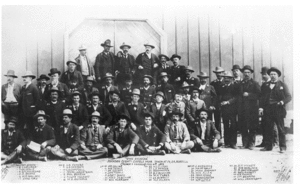Johnson County War
| Johnson County War | |||
|---|---|---|---|

"The Invaders" of The Johnson County Cattle War. Photo taken at Fort D.A. Russell near Cheyenne, Wyoming, May 1892
|
|||
| Date | 1889–1893 (Bulk 1892) | ||
| Location | Powder River Country, Wyoming, United States | ||
| Causes | Land disputes | ||
| Result | Drastic economical change in Wyoming including the end of the open-range and monopoly | ||
| Parties to the civil conflict | |||
|
|
|||
| Lead figures | |||
|
|
|||
| Number | |||
|
|||
| Casualties | |||
| 20–25 killed (including those who were lynched) | |||
The Johnson County War, also known as the War on Powder River and the Wyoming Range War, was a series of range conflicts that took place in Johnson County, Wyoming between 1889 and 1893. The conflicts started when cattle companies ruthlessly persecuted supposed rustlers throughout the grazing lands of Wyoming. As tensions swelled between the large established ranchers and the smaller settlers in the state, violence finally culminated in Powder River Country, when the ranchers hired armed gunmen to invade the county and wipe out or scare off the small settlers they were competing against. When word came out of the gunmen's initial incursion in the territory, the small farmers and ranchers, as well as the state lawmen, formed a posse of 200 men to fight them, which led to a grueling stand-off. The war ended when the United States Cavalry, on the orders of President Benjamin Harrison, relieved the two forces.
The events have since become a highly mythologized and symbolic story of the Wild West, and over the years variations of the storyline have come to include some of its most famous historical figures. In addition to being one of the most well-known range wars of the American frontier, its themes, especially the theme of class warfare, have served as a basis for numerous popular novels, films, and television shows of the Western genre.
Conflict over land was a common occurrence in the development of the American West, but was particularly prevalent during the late 19th century, when large portions of the West were being settled by white Americans for the first time through the homesteading act. It is a period which historian Richard Maxwell Brown has called the "Western Civil War of Incorporation," of which the Johnson County War was a part.
...
Wikipedia
